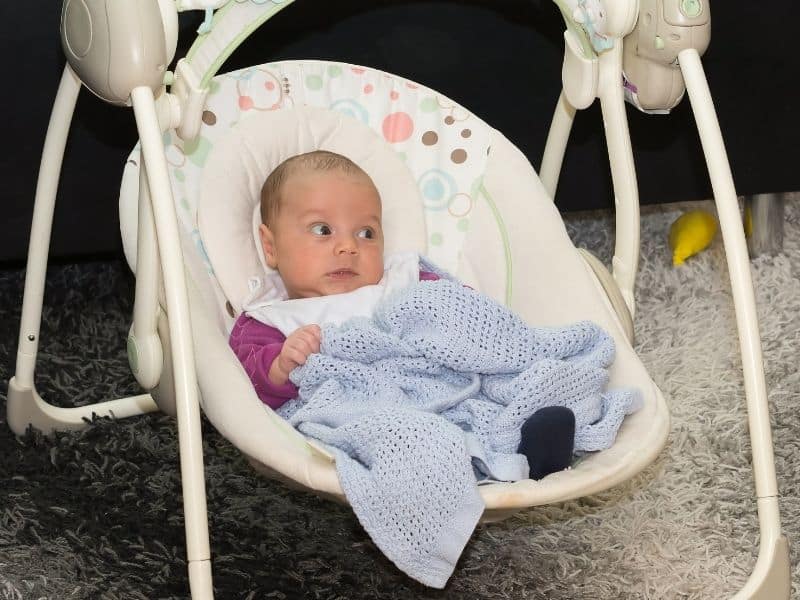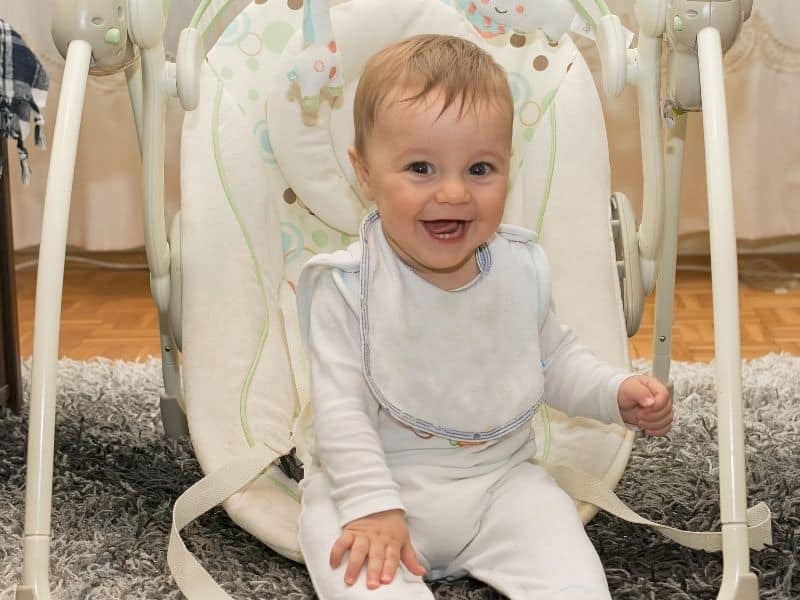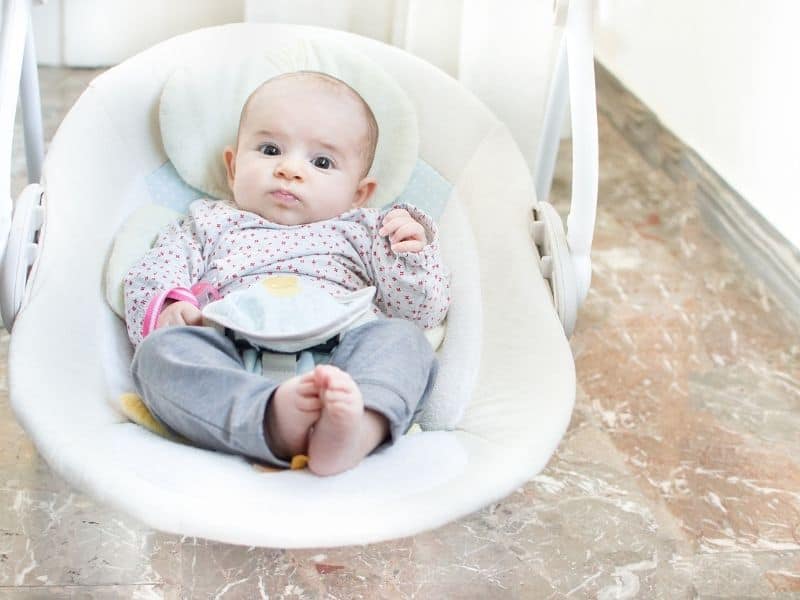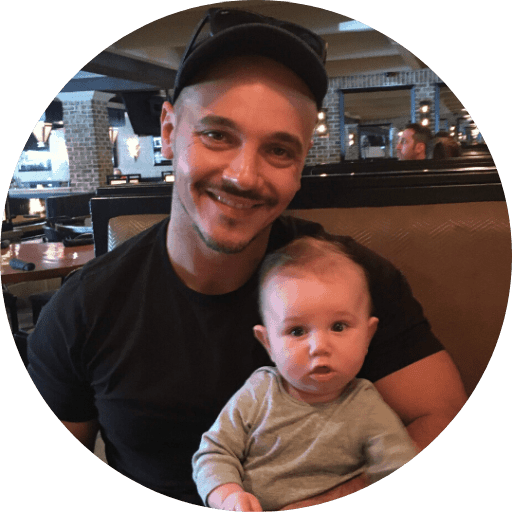This is not a simple question with a clear-cut answer.

For three reasons:
- Because the effects of swings on the activation of spine muscles (Cervical paraspinal and erector spinae) are under-researched.
- Because a swing can affect the spinal development even if the baby doesn’t sleep in it.
- Because swing safety goes way beyond what’s good or bad for the spine.
Today, I’ll sift through all the available information and present only the relevant bits.
By the end of this guide, you’ll know more about the swing-spine health connection than 99% of parents out there.
First things first – let’s take a step back and answer a fundamental question.
Should a baby sleep in the swing?
No, they shouldn’t.
The AAP (American Academy of Pediatrics) advises against it because it increases the risk of SIDS. Babies should only sleep on a flat, firm surface.
You can read more on that here – can baby sleep in a swing?
Oh, I know you’re mad at me right now.
Take a breather.
I can almost hear you thinking, “But they love it…”
Don’t kill the messenger, but it doesn’t matter if they love it.
It doesn’t even matter if the swing is the ONLY place where they fall asleep.
It’s not safe, and there’s no room for compromise.
I will, however, give you a few precise guidelines on what you can do to get the most out of the swing – right after we deal with the spine thing.
I guess that answers it, then…right?
Not really.
We did answer the question from the title, but that’s not the whole story.
Not even close.
To use a baby swing responsibly, you’ll need to understand the basics of spine development and the risks a swing might pose.
Let’s put a pin in that for now.
Five phases of baby spine development
Phase 1 – the primary spine curve
“Primary curve” is a term we use to describe the fetal curve that develops in utero to protect the baby from possible trauma at birth.
A baby that’s just entered the world shouldn’t be forced into a face-up position right away because of that fetal curve of the middle spine.
Phase 2 – promoting thoracic kyphosis in newborns
Use a sling in a side-lying position when carrying newborns for prolonged periods. It allows their spine to develop natural kyphosis (backward curve) in the thoracic area.
The one main mistake you can make here is placing them upright too early. Start using a front or rear pack in the upright position only when the baby can pull up and stand for at least 2-3 minutes.
Going upright too soon can lead to scoliosis and other forms of spinal instability.
My point – the use of a swing and bouncers for longer than recommended might interfere with the development of natural kyphosis.
The key words here are “for longer than recommended.”
To read more on that follow these links:
When to stop using a baby swing
How long can newborn be in a swing?
Phase 3 – secondary spinal curves development in months 3-6
‘Secondary curve’ is a term we use for lumbar and cervical lordosis (forward curve). These curves form as the baby lifts the neck and head of the surface during tummy time and as it starts to crawl.
Cervical lordosis is why lots of tummy time is recommended in months 3-6.
They might need encouragement to lift their head. You can make it all interesting by laying on the floor in front of them and doing the same – lifting your head while laying on your stomach.

They’re likely to mimic you and see it as a game.
Along with the thoracic kyphosis from Phase 2, the secondary curves make the final healthy shape of a baby’s spine.
Phase 4 – lumbar lordosis in baby spine development (months 6-12)
This is when the final spine shape sets in as the baby crawl and develops lumbar lordosis.
As they start to crawl, encourage it by placing objects they like in front of them.
The cross crawl
As the ‘final touch’ in healthy spine development, lay the baby on their baby and touch the opposite hand to toe.
This exercise is known as cross crawl.
It’s a biggie because it promotes the neural pathways needed for criss-cross crawling. And the importance of that movement goes way beyond the scope of spine development – it’s key to gross and fine motor skills.
You might hear parents bragging about their baby going from butt-sliding to running as if it’s a good thing.
It’s not.
A baby that skips crawling is a baby with a high chance of developing scoliosis.
But we’re interested in the spine and swings. It will all make sense in a minute, I promise – we only have one phase to go.
Phase 5 – 12+ months – walk attempts and the spine
This might change the way you look at those walk attempts even when they’re not successful.
It’s not just about walking – it’s about not missing any stages in spine development. So, allow them to pull themselves up, and only when they’ve mastered that, encourage them to walk.
So, how it all ties in with swings and other baby gear?
Here’s a crude way to put it – look at the phases above and ask yourself if your practices with the baby swing interfere with any of the phases.
You’ll likely be able to pinpoint what exactly you might be doing wrong.
Here’s a more polished (and valuable) way to put it – as long as you follow the guidelines I’m about to go over, a swing is a safe piece of baby gear – both for their spine and in general.

The AAP guidelines for using baby swings
- In babies 4 months or younger – use only the most-reclined position of the baby swing.
- Limit the time in the swing to an hour a day, divided at least into two chunks of 20-30 minutes max.
- Choose a robust swing that’s not likely to tip over and use the safety straps.
- Go with reputable brands (like Mamaroo or Graco, you can read more on those here – mamaroo swing review, mamaroo swing vs graco swing )
- No overhead mobiles or toys that the baby might reach and pull down.
- The cradle part of the swing should stay flat at all times – both when still and when moving.
- Stay aware of the weight and size limits.
The bottom line about baby swings and spine
The critical question is whether the movement of the swing is safe for the spine.
The answer to that is yes, too much time in a swing can be detrimental to your baby’s spine health.
However, sleeping in the swing is not safe in the first place.
That’s why this piece turned into an analysis of baby spine health and how that relates to swings – not sleeping in a swing.
There’s a big difference.
I might have rambled on at times, and for that, I apologize…some questions just aren’t as simple as they sound.
For another interesting read on this topic, find out if baby swings can cause brain damage in this detailed post.
Paul is a passionate dad who founded Upside Dad to share his parenting journey with other new parents. He graduated from Concordia University and worked as a test engineer for over a decade. Paul loves dad jokes and craft beer.
Learn more about Paul and Upside Dad here.
